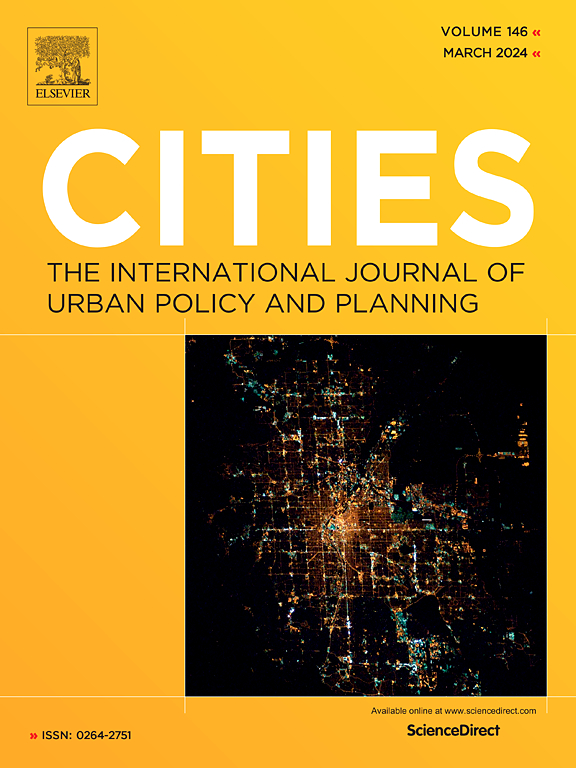揭示多重行动者影响下的非工作旅行模式:基于地理空间主体的综合方法
IF 6.6
1区 经济学
Q1 URBAN STUDIES
引用次数: 0
摘要
基于活动的建模本质上是复杂的,包含了各种各样的假设、参与者和紧急模式。揭示潜在的不确定性需要整合各种各样的模型和参与者,并检查在整个建模过程中实现的不同假设。基于代理的模型(ABMs)被认为是解决基于活动建模中固有复杂性的强大工具。尽管活动相关通勤模型的优势已经被证明,但在两个关键领域仍需要进一步探索:应用综合地理空间模型定义活动相关通勤模型中的空间参与者,以及利用模式识别方法(包括Global Moran’s I和Local Indicators of spatial Association, LISA)来揭示活动相关通勤的隐藏机制。本文提出了一种综合地理空间- abm方法来解决这一差距。利用实际数据和误差百分比程序对Geospatial-ABM进行了局部验证,以确保其鲁棒性。模型验证的平均误差为8.8%,显示了其强大的泛化潜力。以伊朗赞詹为例进行了案例研究,使用了关于旅行产生、建筑环境特征和调查旅行行为的数据。模拟结果的描述性统计的初步发现表明,购物目的地在城市内通勤中占主导地位,近一半的城市设施访问归因于购物中心。随后的模式识别分析、环境和办公室-银行旅行的结果表明,人们集中在市中心周围,导致市中心白天交通量的暂时激增。本文章由计算机程序翻译,如有差异,请以英文原文为准。
Revealing non-work travel patterns under the influence of multiple actors: An integrated geospatial agent-based approach
Activity-based modeling is inherently complex, encompassing a variety of assumptions, actors, and emergent patterns. Uncovering underlying uncertainties requires integrating a diverse range of models and actors, and examining different assumptions implemented throughout the modeling process. Agent-Based Models (ABMs), are recognized as powerful tools for addressing the complexities inherent in activity-based modeling. Although the advantages of ABMs in activity-based models have been demonstrated, there remains a need for further exploration in two key areas: the application of integrated geospatial models to define spatial actors in ABMs, and the utilization of pattern recognition approaches, including Global Moran's I and Local Indicators of Spatial Association (LISA), to uncover the hidden mechanisms of activity-related commuting. This paper proposes an integrated Geospatial-ABM approach to address this gap. The Geospatial-ABM was validated locally using real-world data and Error percent procedure to ensure its robustness. The model validation resulted in an average percentage error of 8.8 %, showcasing its strong potential for generalization. A case study was conducted for Zanjan, Iran, using data on trip generation, built-environment characteristics, and surveyed travel behavior. The initial findings from the descriptive statistics of the simulation results reveal that shopping destinations are predominant in intra-urban commutes, with nearly half of visits to urban amenities being attributed to shopping centers. Subsequent results from pattern recognition analysis, environmental, and office-bank travels indicate, concentrating around the city-center and leading to a temporary surge in daytime traffic volume in the city center.
求助全文
通过发布文献求助,成功后即可免费获取论文全文。
去求助
来源期刊

Cities
URBAN STUDIES-
CiteScore
11.20
自引率
9.00%
发文量
517
期刊介绍:
Cities offers a comprehensive range of articles on all aspects of urban policy. It provides an international and interdisciplinary platform for the exchange of ideas and information between urban planners and policy makers from national and local government, non-government organizations, academia and consultancy. The primary aims of the journal are to analyse and assess past and present urban development and management as a reflection of effective, ineffective and non-existent planning policies; and the promotion of the implementation of appropriate urban policies in both the developed and the developing world.
 求助内容:
求助内容: 应助结果提醒方式:
应助结果提醒方式:


